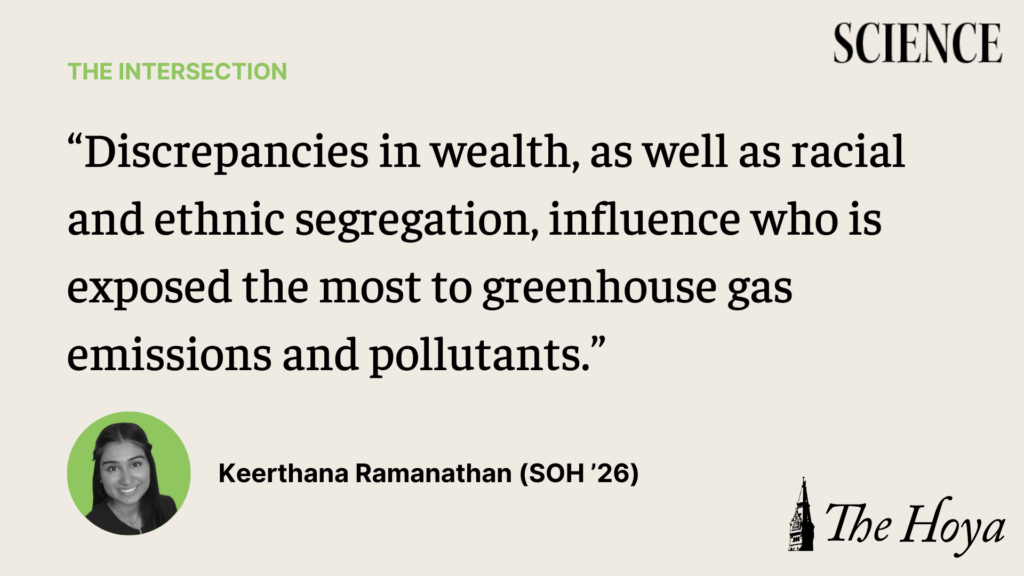Climate change poses an existential threat to life on earth as we know it. Largely driven by fossil fuel use, greenhouse gases have reached the highest level they have ever been in 4.5 billion years. Furthermore, if sea levels continue to rise at the current rate, over 200 million people’s homes will be underwater in 70 years.
Though climate change awareness has grown in the past few decades, scholars are still missing recognition of its important connection to health and medicine.
Foremost, climate change does not affect people equally. In the United States, climate change impacts people of color and low-income communities significantly more than those who are white and wealthy. As a result, the disparities drawn by climate change are known as the “climate gap.”
The climate gap is driven by a plethora of structural inequalities. This is referred to as a “syndemic” — an epidemiological term used to describe a health crisis influenced by many factors. Greenhouse gas emissions are a main culprit.
The health impacts of greenhouse gas emissions are largely driven by systemic inequalities, as described in a recent article published in the New England Journal of Medicine. Discrepancies in wealth, as well as racial and ethnic segregation, influence who is exposed the most to greenhouse gas emissions and pollutants.
The physical separation of people based on economic privilege results in a distinct line between those who suffer the health effects of climate change and those who do not, creating residential and racial segregation. These effects are a direct result of historical redlining, a historical government homeownership program that reinforced racial segregation in neighborhoods. Black communities are still more likely to live in areas of close proximity to industrial areas and associated emissions and live in older homes with less access to resources like heat and electricity, reinforcing patterns of socioeconomic inequality.
Moreover, those who are wealthy can choose to move away from polluted areas, and those who hold significant political power can keep sources of pollution away from their homes. In turn, these people of privilege are less likely to suffer from the health effects of climate change, which include respiratory and cardiovascular disease, injury and deaths related to extreme weather events, vector-borne diseases, infectious diseases and various mental health effects.
Another systemic manifestation of climate change and its unequal impacts is rising temperatures. Heat is — perhaps surprisingly — the deadliest weather-related event in the United States, taking the lives of over 12,000 people per year.
But not all communities equally share this toll. Lower-income neighborhoods comprised of people of color experience temperatures up to 5 to 20 degrees Fahrenheit higher than communities of white, wealthier individuals. This reveals a direct correlation between neighborhoods experiencing the effects of rising temperatures and historical redlining.
The heat disproportionately experienced by lower-income communities of color can directly be attributed to a lack of mitigating techniques. These communities often contain fewer trees, which cool the air, and more paved surfaces, which absorb and radiate heat. According to Vivek Shandas, an urban planning scholar at Portland State University, “It’s uncanny how often we see this pattern. It tells us we really need to better understand what was going on in the past to create these land-use patterns.”
Therefore, communities of color face a double threat: They are more likely to be impacted by climate change and less likely to have access to resources to mitigate it.
An important step in reducing these health effects lies in critically examining the legacy of redlining in large cities. Though redlining is not the only driver of the climate gap, addressing redlining can play an important role in reducing its impacts on already systematically disadvantaged communities.
Another important solution lies in increasing green spaces in vulnerable communities. Even small green spaces can reduce the average temperature of neighborhoods by several degrees, which makes a difference, considering even an average temperature increase of 1 degree can have lasting effects, like increasing mortality rates by up to 2.5%. Green spaces also have the ability to filter polluted air near industrial complexes and reduce overall stress levels.
Climate change and health inequality are undeniably intertwined, and it’s time that we recognize their intersection.









